To many business owners and marketers, the term “growth marketing” may seem redundant. Marketing is what you do to grow a business, so isn’t all marketing growth marketing?

Too many professionals get this definition wrong and end up missing out on major opportunities for growth. So what exactly is it? In this complete guide to growth marketing, we’re going to cover:
- The true definition of growth marketing and its benefits.
- Growth marketing vs traditional marketing and growth hacking.
- How to do it using the five stages of the AARRR framework.
- Growth marketing strategies and important metrics for each stage.
Let’s get started.
What is growth marketing?
To understand growth marketing, let’s take a look at it in comparison to traditional marketing.
Traditional marketing focuses on campaign-oriented short-term goals. It’s typically company-centric, largely focused on acquisition, and most of the planning is opinion-based and evaluated annually.
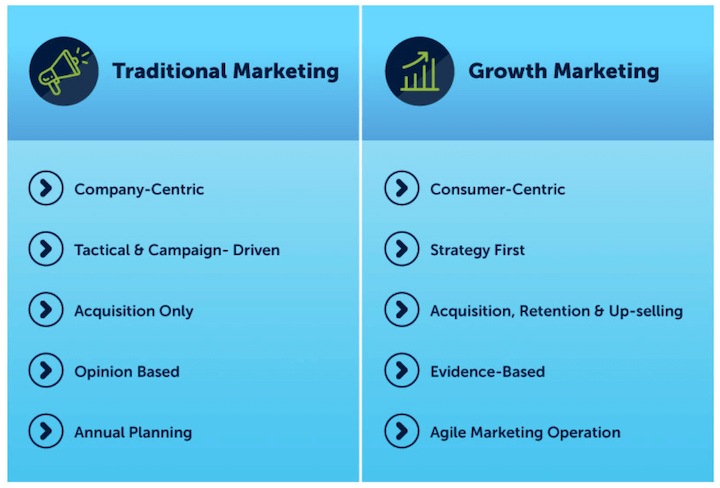
Growth marketing, on the other hand, is strategy-based with long-term goals in mind. Planning is evidence-based and it focuses on acquisition, retention, and cross-selling and upselling,
Simple example of growth marketing
Let’s say your ecommerce business is not making enough money because customers only buy one or two products. The order value is low and the profit doesn’t cover the acquisition costs.
In this case, you might use cross and upselling to get the customer to buy more products the first time, and engagement strategies to get them to buy more often, because with the second or third sale you won’t have any acquisition costs to cover—especially if you use email marketing to communicate with your customers.
Growth marketing vs growth hacking
Growth hacking is not the same as growth marketing. Growth hacking focuses on short-term results while growth marketing focuses on the bigger picture. Here’s a deeper dive into the differences between the two:
- Growth hacking looks to achieve rapid growth, usually with acquisition, while growth marketing seeks to achieve long-term growth with a set of full-funnel strategies.
- Growth hacking looks at data to experiment and refine an outcome, while growth marketing looks at data to identify patterns and refine a strategy.
- Growth hacking involves hands-on tactics with testing and tweaking, while growth marketing involves automated and algorithmic processes with periodic adjustments.
- Growth hacking is centered around business pain points and goals, while growth marketing is centered around customer pain points.
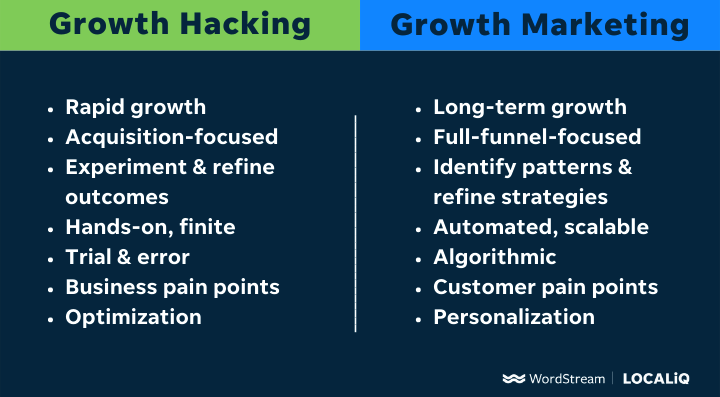
An example of growth hacking in action (Dropbox)
What’s great about growth hacking is that through experimentation and iteration, growth hackers can often develop something unique in a short time—like the Dropbox Referral Program.
The company was having difficulties acquiring new users, and paid ads were not doing the trick. Their growth hack, a double-sided referral program, resulted in a 60% increase in signups.

An example of growth hacking turned growth marketing (Slack)
Slack is the fastest-growing B2B SaaS company in history.
While this freemium communication tool was still in beta, founder Stewart Butterfield used widespread media coverage to invite organizations to request access to the platform and try it out—landing them 8,000 signups in 24 hours and reaching 15,000 signups in two weeks. Now that’s a growth hack.
Over the next six months, Slack gathered feedback from these users to refine the product. Once the tool was launched and Slack established its brand and upward growth curve, it could then focus on more consistent and sustainable strategies for acquiring new users and enhancing the platform’s experience to retain them. And that’s growth marketing.
Slack now has over three million paid users today.
Benefits of a growth marketing strategy
Here are some of the many benefits you stand to gain through a growth marketing mindset:
- Better decisions: Growth marketing eliminates the idea of a gut feeling (as with traditional marketing). This data-packed approach to marketing shows what works and what doesn’t to help you make better decisions.
- Enhanced brand perception: This ideology focuses on understanding the customer journey, delivering better experiences, and establishing personal relationships with the customer—ultimately enhancing your reputation.
- Elasticity: Growth marketing is a scalable strategy. You can scale up or scale back your marketing efforts according to your cash flow instead of blindly spending money on big campaigns.
- Unification: Growth marketing necessitates cross-functional collaboration. The marketing team is as involved as the product and sales team, customer support, and analytics team.
- Achieve revenue targets: With the goal of sustainable progress, growth marketing focuses on agile goals to drive revenue. Rather than shooting in the dark, growth marketing seeks promising targets and works toward achieving them strategically.
Now let’s walk through every stage of the growth marketing funnel and its key metrics.
What is the AARRR framework?
AARRR is one of the most popular frameworks for growth marketing. Also known as the Pirate Funnel, this framework divides your growth strategies into five stages and assigns metrics to map this journey.
- Acquisition: Turn viewers into leads and customers.
- Activation: Create the aha moment where customers realize the true value of your business.
- Retention: Keep customers coming back to purchase or staying subscribed.
- Referral: Turn customers into brand advocates.
- Revenue: Enhance customer lifetime value.
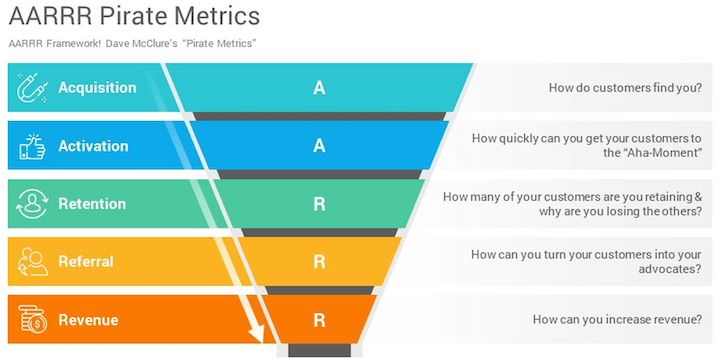
Let’s use this framework here to understand the best strategies and metrics for growth marketing.
Growth marketing strategy: AARRR acquisition stage
Your goal with the acquisition stage of growth marketing is to find the right leads and turn them into customers. It’s the process encompassed in the traditional AIDA model where you take people on the path from awareness to purchase.
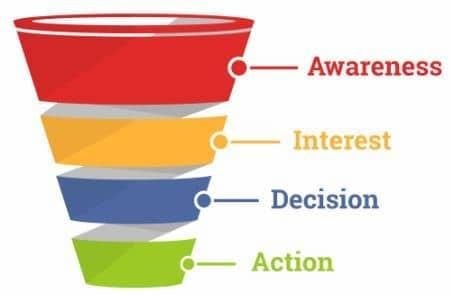
Customer acquisition costs are constantly on the rise. If you want to scale your (bootstrapped) business, you have to build a cost-efficient acquisition strategy. Define your budget for this stage and explore multiple channels to create a set stage for acquiring customers. 51% of companies use at least eight channels to interact with their customers.
Growth marketing strategies for acquisition
This aspect of growth marketing encompasses a number of marketing strategies and channels, but here are a few examples.
1. Content marketing
Create a lead-generating content marketing strategy through blog posts, ebooks, online courses, videos, and more that inform, educate, and interest your audience. This demonstrates your expertise, authenticates your business, builds trust with your audience, and drives traffic to your website where you can convert them into leads and customers.
2. Create a community around your brand
Add value for your target audience by building a community around your specialty. For example, CRM brand Pipedrive has a knowledge hub dedicated to sales professionals with useful content and the means to share knowledge with their peers.
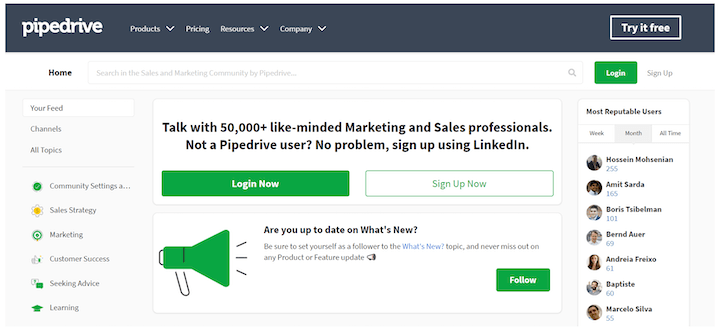
3. Create a free tool
Always address your target audience’s pain points. Offering them something they need will naturally increase their interest in your product or service. Build something useful—like Hubspot’s set of free tools ideal for different segments of its user base, or WordStream’s free Google Ads Performance Grader.
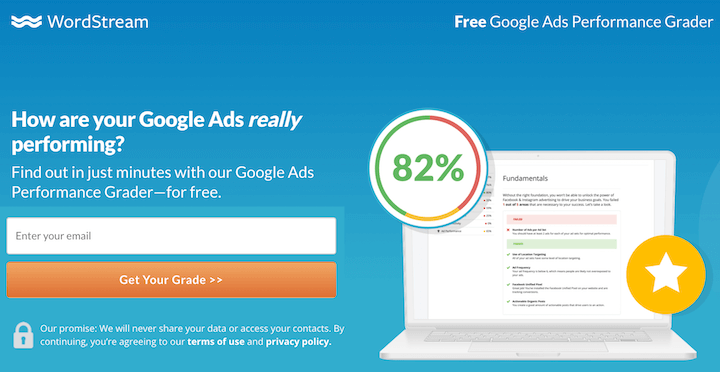
4. List your products on Product Hunt
List your product on Product Hunt to boost your visibility. Optimize your listing with keywords, attractive and visual content, well-timed launches, and upvote invitations
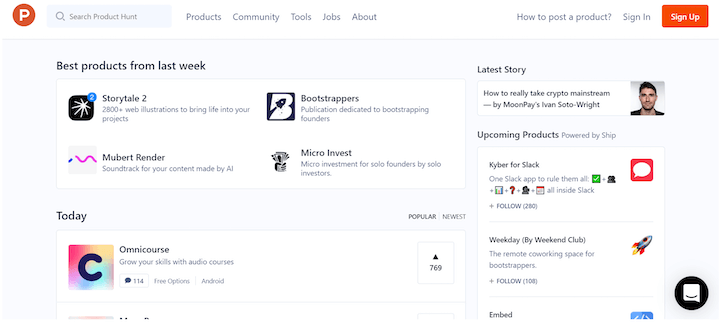
5. Build an automated LinkedIn lead generation machine
As a B2B brand, you can make turn LinkedIn into a lead generation machine by optimizing your company page, building a hyper-engaged network, creating value-packed content, and through targeted outreach. You can even build a sales pipeline through video nurture campaigns.
6. Leverage YouTube ads
Running ads on YouTube is both affordable and effective. A top-notch promotional or explainer video can reach a large audience and generate interest—like this one by Hello Fresh.
7. Exit-intent popups
Use exit intent popups to elicit some action from the users.
AARRR metrics for acquisition stage
Since there are so many different strategies involved in acquisition, your metrics will depend on the platforms you use.
- Channel-specific metrics: PPC metrics, SEO metrics, social media metrics, email metrics, and more. An important metric is cost per acquisition (CPA) also known as cost per action or cost per conversion, which is how much it costs to acquire a lead.
- Conversion rate: Test the conversion rate for different channels, including your website, landing page, social media, and emails. This metric compares the total number of conversions within a bigger pool of interactions.
- Customer acquisition cost (CAC): This metric measures the cost to acquire a customer. While CPA is a campaign-level metric, CAC is more of an overarching business-level metric that divides the total cost of all your marketing efforts (online and offline) by the total number of paying customers generated in a given time period.
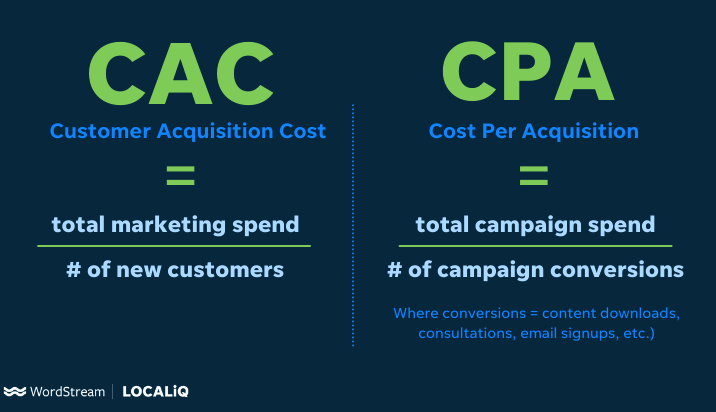
Don’t confuse CAC with CPA!
Growth marketing strategy: AARRR activation stage
The activation stage is when customers using your product or service realize the true and unique value your business offers. So it’s all about providing the best customer experience and integretating that “aha moment” into your customer’s journey.
The fact that a customer is five times more likely to purchase again from you has motivated companies to invest in customer experiences, ultimately fuelling the popularity of growth marketing.
Growth marketing strategies for activation
What makes for the best customer experience? Personalization. 80% of customers shop from brands that create personalized experiences for them.
8. Use personalization technology
Personalization technology enhances the customer experience, building loyalty, multiplying conversion rates, decreasing cart abandonment, and increasing average order value. Ecommerce brands can create a customized shopping experience to suit the shoppers’ preferences, while B2B brands can personalize their website based on behaviors and context with tools like Hyperise.
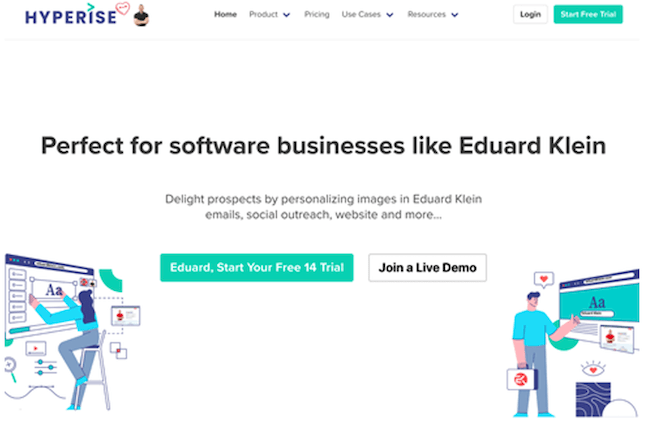
Another example of personalization technology is dynamic LinkedIn outreach personalization, where you can send personalized messages and images to contact prospects and drive conversion rates.
Head here for more ways to gain and retain clients through B2B marketing automation.
9. Create hyper-personalized email campaigns
Along with your website and videos, you can also hyper-personalize your email campaigns to create more meaningful communication with your customers—from onboarding and welcome emails to feature announcement and feedback emails.
10. Use chatbots and video chats
Customer support is one of the most important aspects of user experience. Automating the sales and support process allows you to optimize communication with your leads and customers. Chatbots and video chat tools are great options for doing so.
11. Conversion rate optimization
For both the acquisition and activation phases, conversion rate optimization is key. By creating a conversion funnel based on the actions you want your website visitors to take, you can find dropoff points and identify ways to patch them up through segmentation and A/B testing.
Using a data-driven approach, you can remove the guesswork about what your leads and customers like and create the best experience on your website, social media profiles, emails, landing pages, and more.
AARRR metrics for activation
Here are some metrics to help you formulate your “aha moment.”
- Active users: The daily active user (DAU) count is crucial to determine user engagement. This metric allows you to see if users find utility in your product or service.
- Abandonment rate: This metric looks at the percentage of users leaving before they complete the desired action. It gives you an insight into the stage where the users are leaving and helps you take the right mitigation measures.
- Activation rate: This metric measures the pace at which new customers find the optimum value in your product or service. You have to define a particular action to deem a user “activated” when performing this action. The activation rate then calculates the number of users who performed this action against the total number of users who signed up.
Your customers will become loyal customers only when they find value in your product or service. Keep an eye on whether they feel satisfied with your brand through these metrics. Evaluating this data will allow you to take timely action and reduce churn.
Growth marketing strategy: AARRR retention stage
The retention stage, as the name suggests, aims to retain your existing customers by providing consistent value that in turn further strengthens customer loyalty and reduces churn rates. It’s about proactively managing the customer experience.
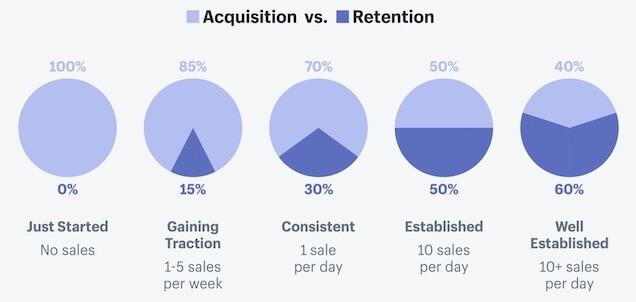
Growth marketing strategies for retention
The best way to retain customers is to engage with them consistently. From the moment they sign up to the moment they buy a product or take a premium subscription, send them helpful content, offers, and support to keep them engaged and taking action. Here are some of the best customer retention strategies out there.
12. Send personalized email perks
Make the most of marketing automation with email automation tools like MailChimp to communicate with your customers and keep them returning to your website. Use these free small business email templates for help!
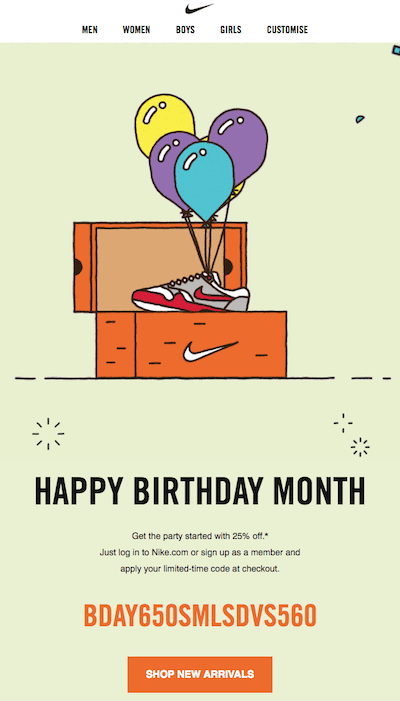
13. Run reenagement campaigns
According to RJMetrics, a company with a 2.5% churn rate can become 50% larger in five years than a company with a 5% churn rate. That’s how big difference churn rates can make!
Devise methods to reduce churn rates using targeted reengagenemt emails. Use behavioral segmentation to identify people who have gone dormant and send targeted emails to identify and solve their pain points. Groove did this and reduced their churn rate to 1.6%.
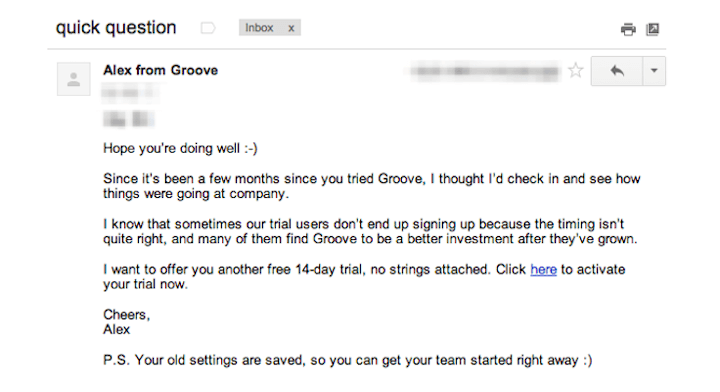
Find these patterns for your business—understand user behavior at different points on your website or product using data. Evaluate this data to identify patterns of this behavior and arrive at reasons for your churn rate.
14. Run rewards promos and programs
A big part of customer retention is making them feel special. Reward your loyal customers and express gratitude by sending special discounts and offers, early access to sales, a freebie, thank you notes, or new products tailored to them. Give them reasons to feel special and feel closer to your brand.
VIP and loyalty programs incentivize users’ loyalty and create exclusivity to build a stronger connection. Sephora’s Beauty Insider program is a perfect example of how brands retain customers through appreciation.

15. Build strong employee loyalty
Your customers can only be as happy as your employees. Create core company values and cultivate a culture of freedom and happiness for your employees to strengthen their loyalty towards your company. Their feelings will naturally reflect in how they talk to your customers and ultimately drive retention rates.
16. Create a customer support knowledge base
In addition to providing blog articles and social media content that educate your audience and bring in leads, consider creating a learning hub for your product specifically, like Asana.
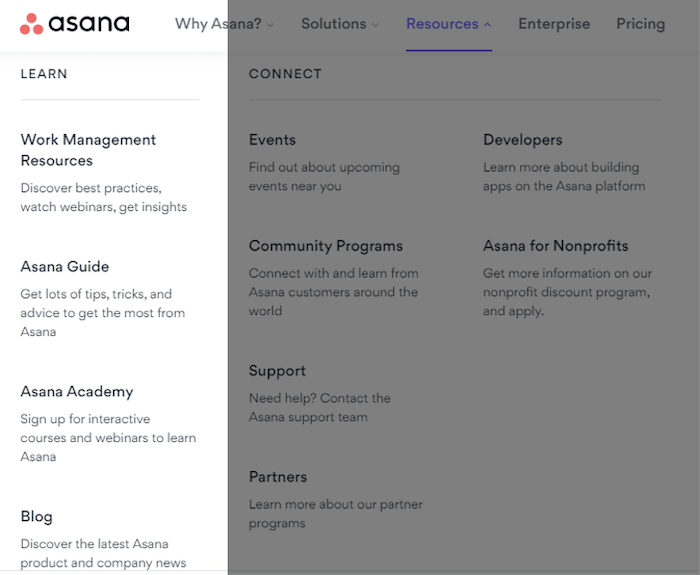
Building a knowledge base and hosting online courses will allow you to:
- Establish credibility as a brand
- Onboard new customers with ease
- Troubleshoot any problems
- Enhance customer engagement and satisfaction
AARRR metrics for retention
By analyzing these metrics, you’ll be able to revise your retention strategies for better results and build a solid recurring client base for your business.
- Customer retention rate (CRR): This metric shows how many customers actively use your product or service. It looks at the number of customers who remained with you by deducting the new acquisition in the concerned period.
- Churn rate (for SaaS or app): The churn rate measures how many users have stopped using the product. Also known as the attrition rate, it measures the number of customers who have left the app in a given period.
- Increased average order value: This metric allows you to measure how much customers buy more from you compared to baseline. An increase in the average order value means the customers are happy with your product and eager to buy more.
- Average customer lifespan: An average customer lifespan is the number of days between the customer’s first order date and last order date.
- Reactivation rate: Reactivation is when you’re converting a churned client into an active one. This metric finds the number of churned customers who came back.
Remember, retention is always cheaper than acquisition!
Growth marketing strategy: Referral stage
The referral stage is when you leverage your customers’ loyalty for marketing your brand. It’s when customers love your product or service so much that they willingly recommend it to others.
Growth marketing strategies for the referral stage
Referral marketing is one of the best approaches out there, and there are different types of referral incentives:
- Referrer saves money
- Referrer helps a friend
- Referrer and friend both get something of value
- Referrer contributes to a social cause
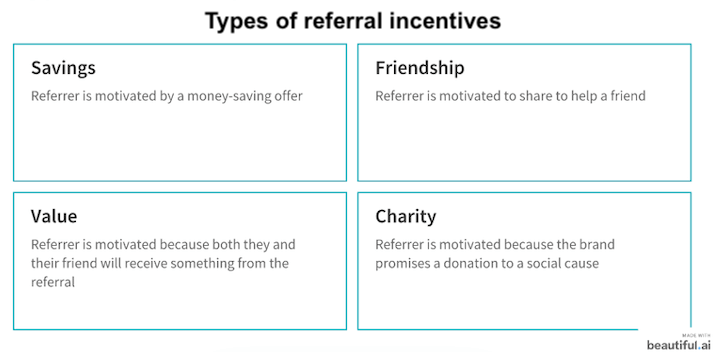
Here are some referral marketing strategies to try.
17. Create a referral program
The first step to make the most of the referral stage is to create your loyal customer base. When you have this loyal base ready, strategize a referral program to promote your products. Italic’s refer a friend program of $30 credit helps to drive signups on their members-only shopping platform.

18. Leverage early adopters as marketers
Some of your earliest users can act as the best marketers for your product or service. Your early adopters are the risk-takers who align themselves with your brand for its core values. Use their belief in your product or service to market the brand effectively and create awareness.
19. Leverage influencers
Influencer marketing is another great strategy for the referral stage. Connect with popular social media influencers in your industry for collaboration and drive sign-ups and conversions through their audience.
AARRR metrics for referral stage
Referrals can be a game-changer for driving your business growth. Analyze these metrics consistently and build on the tactics detailed above to secure the profits of referral marketing.
- Customer referrals: This metric measures how many clients are willingly referring your brand to others. It gives you insight into your customers’ satisfaction levels.
- Customer reviews: Social proof is the key to driving referrals and conversions. Ask for reviews, follow these tips to get more Google reviews, and then analyze them to gauge your customer satisfaction.
- Influencer recommendations: Measure how many influencers are open to recommending your brand or are organically recommending it on social media.
- Net promoter score (NPS): This score measures customer satisfaction based on an array of factors like customer support, pricing, usability, performance, and overall experience
Turn your loyal customers into brand ambassadors and position influencers to promote your product or service.
Growth marketing strategy: AARRR revenue stage
The last stage is about the revenue you can generate from all your marketing efforts. It seeks to enhance customer lifetime value by delivering better experiences, increasing average order value, and enhancing retention rates.
The rule of thumb for boosting revenue is to triple your customer lifetime value against the acquisition costs.
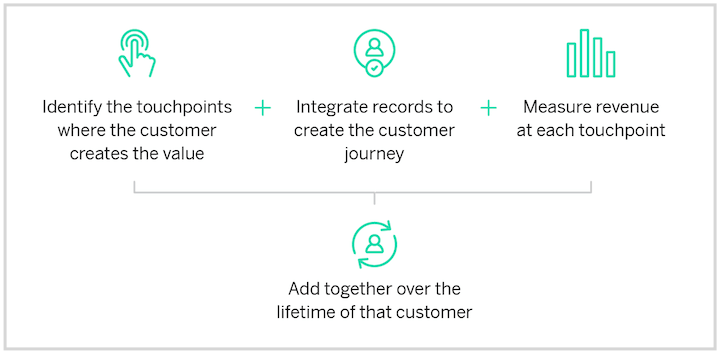
Growth marketing strategies for revenue
A lot of the strategies for enhancing customer lifetime value are built into the previous stages of the growth marketing framework. But here are some:
20. Focus on repeat customers
Look at your analytics and identify the repeat customers to improve their experience. The better brand loyalty you establish, the more revenue you can generate.
21. Promote “eyecatcher” products
Promote entry-level products that work well with additional products. In doing so, you can increase signups and sell more products later, ultimately increasing the customer revenue.
22. Hone your pricing strategy
You might try a price increase. If you have strong customer loyalty towards your product, they are likely willing to pay a substantial price for the same.
AARRR metrics for revenue
Your business growth ultimately lies in the revenue you secure. So, measure these metrics to check the revenue you earn and lose with every customer. These metrics are particularly crucial for subscription-based business models.
- Customer lifetime value (CLV): This metric is crucial to determine the overall customer experience. It measures the value of a customer for your company over the period of their relationship (see average customer lifespan).
- Average revenue per user (ARPU): This metric gives you an idea of the revenue you’re generating from each user in a specific duration. It divides revenue generated in a period by the number of average users in that period.
- Annual recurring revenue (ARR): This metric is for subscription products or services. It evaluates the revenue generated every year for a subscription.
- Monthly recurring revenue (MRR): This metric measures the predicted income from subscriptions sold in a month.
- Revenue churn: This metric looks at the revenue lost in a given period. It calculates the MRR lost in a month and deducts the total price of upgrades or additional services bought in the month.
Keep a check on these numbers to fuel revenue-driven growth for your business.
The real definition of growth marketing (recap)
Growth marketing is more than just a buzzword for growing businesses. It’s a well-devised plan for sustainable progress and taking your business to greater heights. We’ve covered a lot, so let’s recap:
- Growth marketing is a strategy-based, data-driven approach to achieving sustainable success and improving revenue.
- Growth hacking seeks to reach short-term goals or solve a business problem, with rapid experimentation and iteration to produce a solution or product.
- Growth marketing seeks to achieve dominance in the market over time, with a framework of carefully devised strategies that use automation to tailor to customers’ needs and scale.
- Benefits of growth marketing include better decisions through data, improved brand perception, scalability, cross-functional collaboration, and higher revenue.
- AARRR is one of the most popular frameworks for growth marketing and includes acquisition, activation, retention, referral, and revenue.
- Growth marketing strategies and metrics span across the entire lifetime of the customer, not just the campaigns used to acquire them.







